Malta
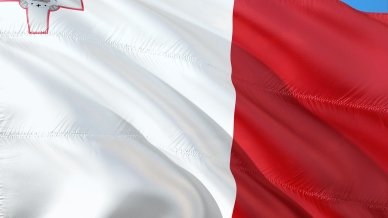
There is no internally sourced freshwater, and all the houses are built of sandstone.
Thus, the buildings in this country are of an unusual but well-recognised golden colour. Even on a rainy day, the streets of its cities seem to be flooded with bright sunlight.
It is beautiful and mysterious, a tiny and majestic Malta. It is a fortress and a fairy tale that lures tourists and migrants from all over the world.

General Information
If you want to spend a vacation in a peaceful and safe country, do not hesitate to buy a package holiday to Malta. This trip will guarantee a range of the most delightful discoveries.
Historical Background
Since the times of Phonecians, this harsh rocky island used to be a honeypot for all conquerors, dreaming of their reign in the Mediterranean Sea region. Its convenient geographical location in the middle of commercial maritime and military routes from Europe to other continents provided the control of enormous monetary and commodity flows and the ability to dictate the terms for other countries.
In that way, Malta bounced from one ruler to another. It used to be under the supremacy of the Phonecians, Greeks, Byzantines, Romans, Arabs, and Spaniards at different times.
Its last owner, King of Spain Charles V, made a generous gift for the Knights Hospitaller and allowed them to settle on the strategically important island. The Order got the name Maltese, and the island itself turned to the shelter for courageous hospitallers for 268 years who were fighting with the Ottomans and their allies — the Arabs and Berbers.
At the end of the 18th century, Malta ended up under the conquest of Napoleon’s army, but the French rule was not long-lasting. In December 1798, the Russian Emperor Paul I was elected as the Grand Master of the Maltese Order. That gave him the right to make long-term plans for the admission of Malta to the Russian Empire and gain complete control over the entire Mediterranean region.
However, those plans did not become real. In September 1800, the British troops occupied the island. In a couple of months, in March 1801, Paul I was killed. The heir to the Russian throne, Paul’s son — Alexander I, did not reconquer the strategic island and, moreover, rejected the father’s pursuit of dominance in the Mediterranean Sea.
In 1814, Malta came under the control of Great Britain. The British military base settled on the island for more than 150 years.
A real battle began during World War II. Multimetre, thick walls of the fortress surrounding the island, a magnificent construction, and an invincible spirit of local people made the country an impregnable bastion for Hitler’s army, trying their hardest to occupy it.
The defense lasted two and a half years (from June 1940 to December 1942) and ended with the retreat of German troops. The people of Malta were awarded the George Cross, the highest award of the British Empire.
In 1964, Malta gained independence but only within the British Commonwealth. It remained the state under the rule of the British Queen as a monarch. The country became a fully independent republic only in the 1970s. The British army was withdrawn, and the bases were closed in 1979.
Malta has been an EU member since 2004. And the legendary Maltese Order is not situated on the island anymore. In the middle of the 19th century, the world’s oldest Knights’ Order relocated to Rome.
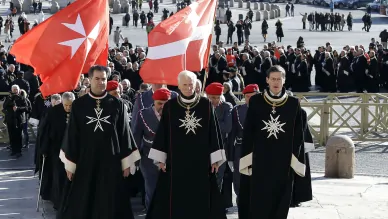
The Knights of Malta colorfully march through St. Peter's Square in Vatican City to celebrate its 900th anniversary
Geography and Climate
Malta is an entire archipelago comprising several islands. And the biggest one is Malta itself, which stretches 27 km long and 15 km wide.
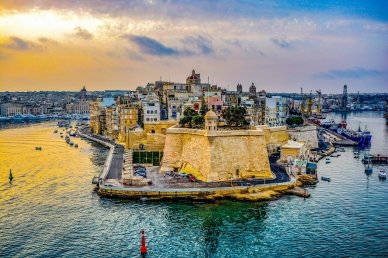
Malta Island, Malta
Gozo is the second biggest and most significant island, twice smaller than Malta. The other five islands are tiny, two of which are uninhabited (St Paul’s Island and Filfla).
Some people live on Comino, Cominotto, and Filfoletta. Though Malta has a small population, it is one of the most densely populated European countries.
There is not any freshwater river or lake on the archipelago islands. That is why the potable water is either delivered or obtained at desalination plants, or in other words, very expensive.
There are no fertile lands either. The entire territory of the islands constitutes the rocks. Therefore, Malta does not have developed agriculture and food manufacturing.
The import of products from neighbouring Italy and other EU countries has a tremendous impact on their cost. Vegetables and meat are the most expensive products in Malta.
There is a typical Mediterranean climate with humid, mild winters and hot, dry summer. In winter, it rains very often, and the average temperature ranges from +7°C to +10°C. And in summer, the heat may reach +32°C - +35°C. However, there has been a record temperature of +42°C.
The Gozo and Comino coasts have been included in Europe’s top three and given many awards for complying with ecological standards.
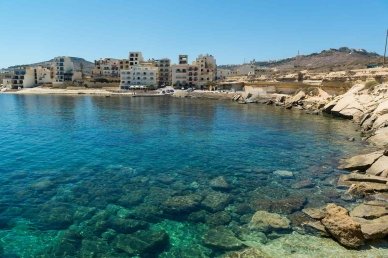
Marsalforn Bay, Gozo Island, Malta
Population, Language, and Currency
The entire population of the Maltese archipelago is just over half a million. According to recent figures, approximately 518,000 people live here.
Maltese and English are the two official languages. Italian is also widespread due to the geographical proximity of Malta to Italy.
Maltese is an exceptional phenomenon. It belongs to the group of Semitic languages but sounds like Tunisian Arabic.
English is not only the official language, but it is also professionally taught for foreigners. In Malta, there are many language schools and seasonal camps for children and youths who can perfectly combine having rest with studying English.
Around 98% of residents of this Mediterranean country adhere to Catholicism and hold Paul the Apostle in the highest reverence as a saint. According to the Biblical legend, his ship crashed near the rocky coast of the Maltese archipelago. But the Apostle did not sink into despair; he began promoting the ideas of Christianity among local people. And he succeeded a lot.
The biggest Maltese city is Valetta, the capital with 6,000 residents. Interestingly, the city’s suburbs are overpopulated — there live around 400,000 people. Therefore, the population in Valetta amounts to a bit more than 400,000 residents.
Birkirkara is the second-largest city with a population of 25,000 people.
Apart from the indigenous residents, a considerable number are migrants from Tunisia, Morocco, Spain, and Italy. Malta also attracts the British elderly for relocation as they appreciate its mild climate, the proximity of the sea, excellent ecology, and almost complete absence of criminal activity.
In 2008, the euro replaced the Maltese lira and became the official currency.
Directions
Malta is an island country, so the main option of getting there is by plane. There is only one airport serving all the flights within the islands — Malta International Airport in Luqa.
The busiest airlines are the Aegean, Air Malta, British Airways, EasyJet, Emirates, Ryanair, Turkish Airlines, Wizzair, etc.
The town of Luqa is situated a couple of kilometres from Valetta, so tourists may get to the city by taxi (€15) or by bus (€1.5-€2).
Malta is the party to the Schengen agreement, so travellers from the Schengen zone are allowed to travel without a visa. Besides, there are more than 60 countries, citizens of which are exempt from the visa and can stay in Malta for up to 90 days during the 180-day period for business or tourism purposes. In 2022, it is expected that this category of tourists will also need to register with the ETIAS system to enter Malta without a visa.
However, it is always necessary to check all the details about future travel via the website of national embassies of Malta in different countries.

Accommodation
The Maltese economy is not about traditional and profitable agriculture and food industry as the Mediterranean countries are. Its rocky soils and freshwater shortage cannot guarantee any substantial crop yields.
This rich country (Maltese GDP per capita occupies 25th place in the world rating) generates its budget by the tourism industry and all the related areas.
The hotels in Malta receive around two million tourists annually, and this figure is four times higher than the number of the Maltese population. Needless to say, the level of hospitality industry development in Malta is high.
The Maltese hotel network comprises hotels of various star-rating. What is more important, the number of stars strictly corresponds to the real conditions offered to the tourists.
Departing for Malta, you need to understand that no miracles will happen. In other words, having opted for a two-star or a three-star hotel, you should not expect varied food, an indoor swimming pool, a personal beach, and other amenities of a luxury vacation. The level of service will be of good quality but in a modest way.
The prices for standard doubles in two- and three-star hotels range from $50 to $180 in the high season per night.
The hotels of four and five stars offer rooms for $250-$350 per night. Though it is expensive, the quality is a good value for money.
The most expensive hotels are situated in the capital city Valetta. During the beach season, from July till the end of August, the prices are soaring in the hotels of such Maltese resorts as St. Julian’s and Sliema.
- Maritim Antonine Hotel & Spa is a four-star hotel located not far from Popeye Village, the place where the legendary cartoon about Popeye the Sailor was shot. The guests are offered comfortable rooms with a full set of amenities. There are several restaurants and a Thai bar (during the high season) within the hotel’s territory.
- Topaz Hotel is a three-star hotel in San Pawl il-Baħar that offers plain and cosy rooms with comfortable furniture, fridges, TV sets, and free Wi-Fi.
- Osborne Hotel is a three-star hotel in Valetta constructed in 1700. It includes 59 rooms with a full set of facilities, including free Wi-Fi and a lift.
- St Julian's Bay Hotel is a three-star hotel in St. Julian’s. There are balconies, air-conditioning, showers, and baths in the rooms as well as free Wi-Fi and coffee machines.
- Plaza Hotel is a three-star hotel in Sliema. All rooms are equipped with air-conditioning and balconies that overlook the magnificent sea. There is a restaurant, a cafe, and a bar within the hotel’s territory as well as free Wi-Fi.
The fans of family or group travel rarely choose hotels as a type of accommodation as it costs a lot. As a rule, they rent an apartment via specialised websites like Airbnb.com or look for a place upon arrival. The price is considerably lower. A well-furnished apartment or a house will cost $120 - $200 per day, and in the case of a long-term tenancy, a discount may be offered.
Places to See
The picturesque nature of the insular Mediterranean region, the harsh romance of the rocks, caves, and grottos, the knights’ castles, ancient temples, and palaces are not the only attractions of old and mysterious Malta.
However, to see all those places, at least half of the month will be necessary to spend in the country, the area of which barely exceeds 300 km2. And for a good reason, Malta has been ranked the world’s top country with the largest number of monuments of antiquity and architecture per square kilometre.
Valletta
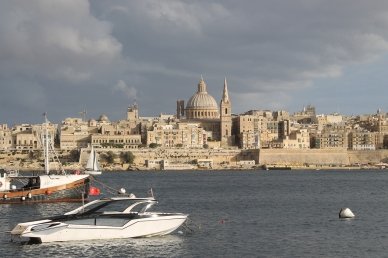
Valletta, Malta
The largest building of the Maltese capital is Il-Palazzo (the Grandmaster’s Palace), built for the Knights Hospitaller in the 16th century. Like almost all buildings in the city, it was constructed of sandstone, the material literally radiating the sunlight. Il-Palazzo bears little resemblance to an ordinary palace. Though the building is large (97m x 83m), it is not architecturally exquisite. It means that the Grandmaster’s Palace is of a minimalist style and looks like a fortress.
Nowadays, it houses the Office of the President of Malta. Sometimes, it is the seat of the government or the venue for the official ceremonies. However, it does not mean that the tourists can have a look at the facades of the Medieval legend only from the side of the Palace Square or the Republic Street.
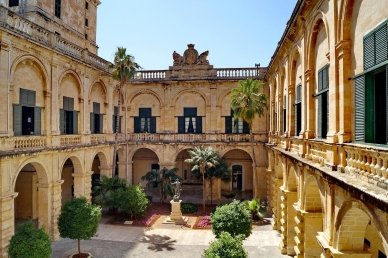
Il-Palazzo (the Grandmaster’s Palace), Valletta, Malta
Tourists can delve into the atmosphere of gloomy luxury of its corridors, halls, and rooms every day from 9 a. m. to 5 p. m. if no official receptions or other occasions have not been planned.
The Supreme Council Hall will amaze with the magnificence of the wall paintings, finely-moulded antique furniture, heavy textile draperies, and beautiful tapestries.
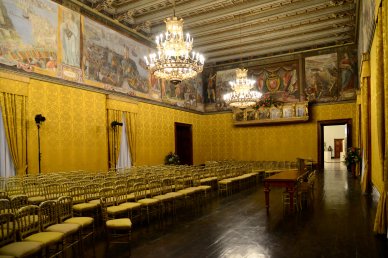
Grandmaster's Palace - Council Hall, Valletta,Malta
The Palace Armoury is the place where an extensive collection of antique armoury used by the Order knights in their fights against numerous enemies is kept. Six thousand firearms, broadswords, sabres, pistols, muskets, and many other weapons will fascinate everyone, even the person indifferent to it.
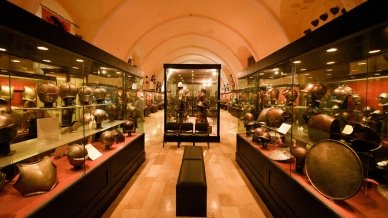
Armory at the Grandmaster's Palace, Valletta
When walking in the southern part of the city, you should definitely visit two botanical gardens, which are very similar to each other and are called the Lower and Upper.
The gardens are planted as longlines and serve as the habitat for rare species of animals and birds in the middle of the bright Maltese nature environment. Sculptures, small gazebos, and fountains create a peculiar atmosphere of tranquility and peace. And the viewing decks open the magnificent views of the bay.
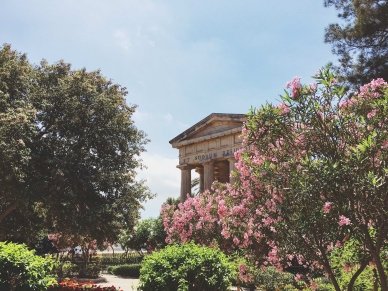
Lower Barrakka Gardens in Valletta
A dramatic history of the heroic battle of the Maltese against Hitler’s army has been featured in the exhibits of the Lascaris War Rooms — the underground tunnels with a multitude of caves and twists.
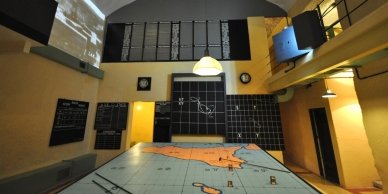
The Lascaris War Rooms
The Hypogeum of Ħal Saflieni
The unique complex of temples carved right in the calcareous rocks is a well-known attraction of Malta and a UNESCO World Heritage site.
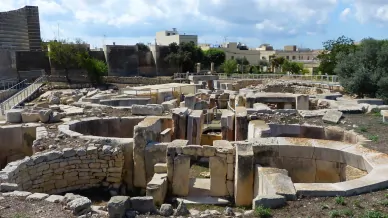
Ħal Saflieni Hypogeum
You can get there driving several kilometres to the south of Valletta. Hypogeum consists of 34 halls, which served as a so-called shrine for people of ancient Malta 6,000 years ago, as the scientists assume.
Currently, only half of the chambers are available for attendance. The most interesting is the Oracle Room of exceptional acoustics. If to pronounce something in a low male voice there, the sound will be immediately heard in all other temple chambers. Interestingly, such an effect is not produced with the sounds of other voices.
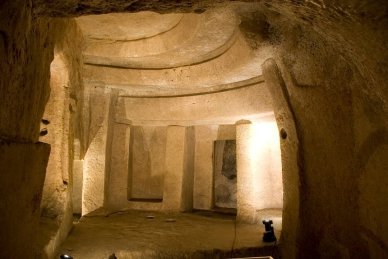
The Oracle Room in Hypogeum Hal Saflieni
Megalithic temples of Malta make a special reason to visit this unusual island for those keen on the history of antiquity. Of course, most of them have been ruined, and not always by wars or natural disasters. The Maltese villagers left no stone unturned within the ancient constructions in their attempt to tear from the harsh nature a piece of rocky land.
However, a few of those monuments have remained. For example, there is Borġ in-Nadur near the city of Birżebbuġa, Broshtorff circle on the Gozo island, Tal-Qadi Temple in Salina, and others. All of them are the UNESCO World Heritage Sites.
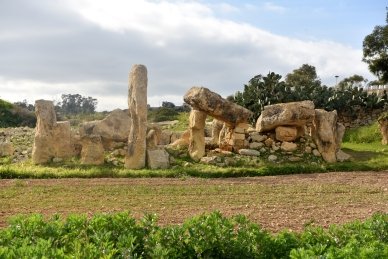
Borġ in-Nadur Prehistoric Complex, Malta
Food
Maltese cuisine is a bright mixture of cooking traditions of the Mediterranean countries, Arab Africa, and Great Britain.
This food is sunny like Italian, exquisite like French, spicy like Arabic, and filling like British.
The basis of any Maltese menu is fish, seafood, and Italian pasta. Many tourists coming to Malta for the first time after their trips to Italy may feel confused and even disappointed because of the absence of authenticity.
An Italian pattern is a distinctive feature of authentic Maltese cuisine. However, there are many dishes that can be hardly encountered outside the island:
Ġbejna is a small, round, sheep-milk cheese usually eaten with much pepper, and it adds some unusual flavours.

Maltese cheese Ġbejna
Stewed rabbit (Stuffat tal-Fenek) is cooked in a ripe tomato sauce with many spices and herbs.

Maltese Stewed rabbit (Stuffat tal-Fenek)
Hobz biz-zejt is a national snack made of coal-baked bread (hobz), the slices of which are soaked in olive oil and tomato sauce with pieces of tomatoes.
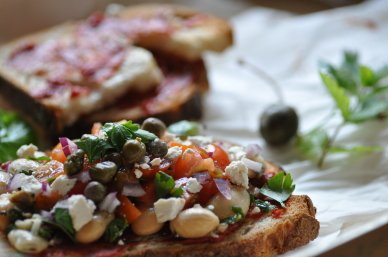
Maltese Hobz biz-zejt
The other types of Maltese food do not differ much from dishes of Sicilian, French, or Spanish cuisine.
This Mediterranean country is old and young at the same time. It sparkles with the sunshine of the hot Mediterranean sun and allures with the harsh beauty of its rocks, caves, and grottos. It whirls with a myriad of the most overriding impressions. For a good reason, there was a saying that whoever owned Malta could own the whole world.
FAQ
How big is Malta?
Malta is a small island nation with a total area of approximately 316 square kilometers.
What are the neighboring countries of Malta?
Malta is an island country in the Mediterranean Sea and does not share land borders with any countries. Its nearest neighbors are Italy to the north, Tunisia to the west, and Libya to the south.
What is Malta's capital city?
The capital city of Malta is Valletta.
What is Malta's population?
Malta has a population of about 500,000 people.
What language is mostly spoken in Malta?
The official languages of Malta are Maltese and English. Maltese is the most widely spoken language.
What is the main religion of Malta?
The main religion in Malta is Roman Catholicism.
What form of government is used in Malta?
Malta is a parliamentary republic. The President serves as the head of state, and there is a Prime Minister who is the head of government.
Does Malta have a good economy?
Malta has a high-income economy, which is diverse and largely based on services, including tourism, financial services, and online gaming.
What is the official currency of Malta?
The official currency of Malta is the Euro (EUR).
Is Malta in the eurozone?
Yes, Malta is a member of the eurozone and uses the Euro as its currency.
Is Malta in Schengen?
Yes, Malta is part of the Schengen Area.
Why is Malta so famous?
Malta is famous for its rich history, stunning Mediterranean landscapes, historic sites, beautiful beaches, and vibrant tourism industry. Its unique architecture and historical significance, including ancient megalithic temples, also attract visitors.
What documents do I need to enter Malta?
Visitors to Malta typically need a valid passport. EU citizens can enter with an ID card. Visitors from many other countries require a Schengen visa.
Is it safe to travel to Malta on your own?
Yes, Malta is considered safe for solo travelers, with low crime rates and a friendly atmosphere.
Is Malta expensive for tourists?
The cost for tourists in Malta can vary. While it is not the cheapest European destination, many find it reasonably affordable, especially compared to larger Western European countries. Prices for accommodation, food, and activities can vary depending on the season and location.







